The 988 Suicide and Crisis Lifeline, launched in July 2022, provides a fast way for people experiencing a suicidal, mental health, or substance use disorder (SUD) crisis to urgently get help 24 hours a day, 7 days a week.
This national service can be particularly important for rural communities, extending the capacity of limited and strained mental health and SUD services and suicide prevention programs to ensure more people in crisis—or family and friends concerned about someone who is—can access help.
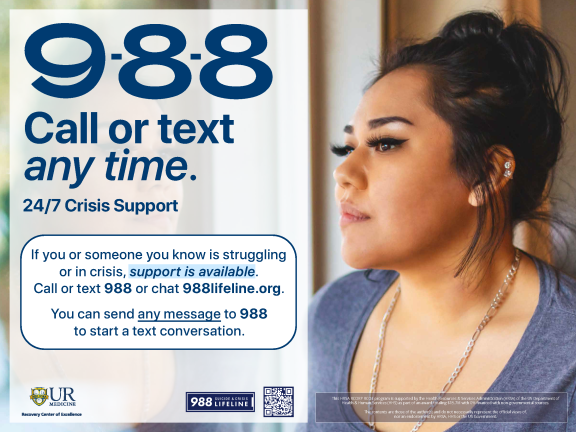
All posters are available for download in the toolkit.
Challenges accessing behavioral health care in rural areas include a severe shortage of providers, lack of specialty mental health and SUD services, distance and transportation barriers, and stigma. Rural residents are unable to obtain treatment as readily or frequently as their urban peers and disproportionately suffer the negative effects of living with unmet or under-met mental health and SUD treatment needs. While rates of mental illness and SUD are similar in rural and urban areas of the U.S., suicide rates are almost two times higher in rural areas versus urban (20.0 per 100,000 in rural versus 11.1 urban).1
The 988 Lifeline offers an emergency safety net of access and connection in times of crisis. To capitalize on this opportunity, it is important to generate widespread awareness about the 988 Lifeline in rural areas.
We have consolidated information from the Substance Abuse and Mental Health Services Administration (SAMHSA) and other resources to help rural communities promote this life-saving service. This resource page and toolkit provide:
- An overview and information helpful for rural communities
- Posters available for download
- Resources and guidance about how local organizations and communities can collaborate and coordinate with the national 988 Lifeline
- Links to comprehensive SAMHSA 988 information including its Partner Toolkit
Key facts about the 988 Lifeline
The 988 Lifeline is for people experiencing suicidal crisis or mental health, SUD, or any kind of emotional distress or for people worried about a loved one in crisis.
988 provides 24/7/365 access to a trained crisis counselor for anyone in a U.S. state, territory, or Tribal community via call, text, or chat.
Lifeline counselors are part of a national network of over 200 local, independent, and state-funded crisis centers across the country, along with a robust national backup network.
988 is free and confidential for callers (chatting is also free; standard data rates from telecommunication mobile carriers may apply to those who text).
988 replaces the National Suicide Prevention Lifeline, which started in 2005. Calls to that 800-273-8255 number are now routed to 988. The new name—988 Suicide and Crisis Lifeline—suggests the broader scope of services provided in addition to suicide prevention.
Modeled after 911, 988 was created as an alternative to 911, which is not designed to handle behavioral health emergencies but is frequently used for lack of alternatives.
Effective crisis support
988 Lifeline crisis counselors are trained to help reduce the intensity of a situation for the person seeking help. According to SAMHSA:
- Almost 98% of people who contact the 988 Lifeline get the crisis support they need through the initial connection and do not require additional services at that moment.
- Numerous studies have shown that most Lifeline callers are significantly more likely to feel less depressed, less overwhelmed, more hopeful, and have less suicidal ideation after speaking to a Lifeline crisis counselor.
Crisis counselors will connect people who need or want additional assistance to local services.
- In these cases, callers may need to disclose their actual location to the 988 Lifeline crisis counselor.
Crisis counselors will only contact emergency services in cases where the risk of harm to self or others is imminent or in progress, the risk cannot be reduced during the call, and when a less invasive plan for the caller’s safety cannot be agreed upon with the individual. (Counselors follow the 988 Lifeline Imminent Risk Policy.)
- Less than 2% of Lifeline calls involve emergency services.
- When emergency services are involved, more than half occur with the caller’s consent.
Equity and inclusion
Lifeline crisis counselors receive cultural competency training.
To ensure access, equity, and inclusion for special populations:
- A pilot program offers specialized call, text, and chat supports for lesbian, gay, bisexual, transgender, queer, questioning, and other sexual and gender minority (LGBTQI+) youth and young adults.
- Veterans who call 988 can press “1” to be routed to the Veterans Crisis Lifeline. (Veterans should continue to text the Veterans Crisis Lifeline short code: 838255).
- Spanish-speaking callers can press “2” to be connected with Spanish-speaking counselors. Over 250 languages are supported through translation services. (Currently, text and chat are available in English only.)
- TTY users can access 988 either through their preferred relay service or by dialing 711, then 1-800-273-8255.
How does 988 connect in rural areas?
SAMHSA’s long-term vision is to transition the 988 Lifeline into a robust crisis-care system across the country that also links callers to community-based providers who can deliver a full range of services, such as mobile crisis teams or stabilization centers. Currently, these services do not exist in all areas, and it will take time and sustained support for this system to develop. In the meantime, anyone in the U.S. can access immediate assistance by calling 988.
All calls are routed through the national number to Lifeline-network crisis centers located closest to them (based on the caller’s area code), with the goal of connecting callers to counselors in their own state or area. Most texts go to the national network since many local centers currently do not support texting.
If the local area does not have a network crisis center or the local crisis center is unable to take the call, the caller is automatically routed to the national backup network of crisis centers.
Who pays for 988?
A joint federal-state program, 988 is run by SAMHSA of the U.S. Department of Health and Human Services and administered by Vibrant Emotional Health.
The federal government significantly increased funding to transition from the National Suicide Prevention Lifeline to the new 988 Lifeline—from $24 million in 2021 to $432 million in 2022— and support its operation, national backup crisis centers, and associated services.
Local crisis centers have long been funded by states, territories, and independent organizations. States and territories are responsible for providing additional funding to support crisis centers as they manage increased call volume generated by 988, as well as fill gaps in the local continuum of care that callers will rely on should they need services beyond a phone conversation.
The federal government has provided more than $255 million in grant opportunities to states and territories this year to help them with added expenses, and SAMHSA will continue to work with states, territories, and Tribal communities directly on efforts to enhance their crisis service capacity.
Recent federal legislation has also given states the opportunity to establish more permanent funding sources to support crisis-care services:
- The 2020 National Suicide Hotline Designation Act that established the 988 Lifeline gave states the ability to pass legislation adding a fee to cell phone bills as a permanent source of funding for 988 and associated mental health services.
- The American Rescue Plan enables states to get reimbursed for community-based mobile crisis services for Medicaid beneficiaries.
Spread the word
Too often, people experiencing suicidal ideation or mental health or SUD distress do not know where to turn in times of crisis. The 988 Lifeline helps fill this vital need. People can call (text or chat) 988 anytime, day or night, to immediately receive compassionate care provided by a trained counselor confidentially and for free.
It is essential to increase awareness about this life-saving service in rural communities where, unfortunately, more people cope with unmet behavioral health needs. SAMHSA’s 988 Partner Toolkit provides a wealth of information—including key messages, fact sheets, logos, and social media materials—to help providers, community leaders, and partners spread the word.
Posters
We offer a variety of posters about 988 for download to help spread the word.
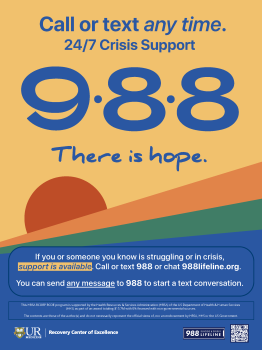
Download poster in English (PDF)
Download poster in Spanish (PDF)
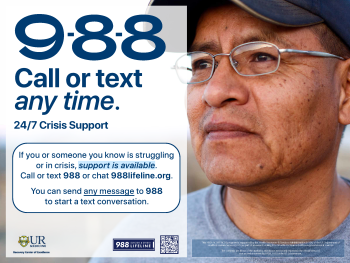
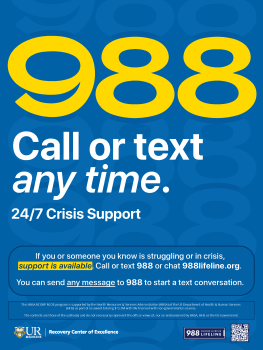
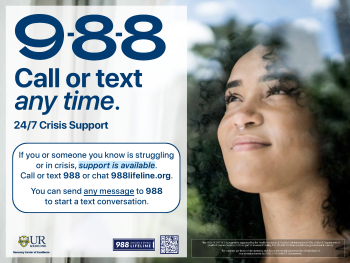

References
[1] Morales, D. A., Barksdale, C. L., & Beckel-Mitchener, A. C. (2020). A call to action to address rural mental health disparities. Journal of Clinical and Translational Science, 4(5), 463–467; National Rural Health Association. (2022). Mental health in rural areas [Policy brief]; Hedegaard, H., Curtin, S. C., & Warner, M. (2018, November). Suicide mortality in the United States, 1999–2017. National Center for Health Statistics Data Brief, (330).
November 2024